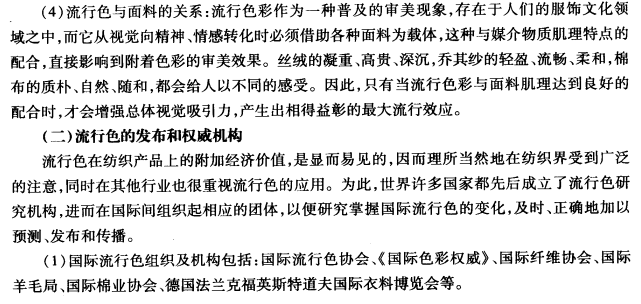(1) The rules and research predictions of fashionable colors “Fashionable color” is a foreign term. Its English name is fashion colour, which is translated as a color that conforms to the fashion of the times. That is “fashionable color”. It refers to several or several groups of colors and tones in products that are particularly popular with consumers in a certain period and region and will become the main selling colors for a while. It exists in various products such as textiles, light industry, food, furniture, urban architecture, interior decoration, etc. However, the most sensitive ones are textile products and clothing, which have the shortest popular cycles and the fastest changes. According to the actual analysis of the evolution of popular colors at home and abroad, the change cycle of popular colors includes four stages, which are generally divided into: initial stage, rising stage, climax stage and fading stage. The entire cycle process roughly lasts for 5-7 years, of which the gold sales period during the climax period is about 1-2 years. However, the length of cyclical changes varies depending on the different economic development levels of countries and regions, social purchasing power and aesthetic requirements for color. Usually the change cycle is fast in developed countries, slow in developing countries, and some poor and backward countries and regions do not even see significant changes. How to accurately predict popular colors in order to achieve good economic and social benefits. For production operators, this is a crucial issue. 1. Research and prediction of popular colors (1) Study the color elements and order characteristics of color science in depth, and fully understand the impact of color changes on people’s physiology, psychology and emotions. (2) Conduct extensive, in-depth and detailed investigation and research on the customs and habits, color likes and dislikes of consumers in different regions and countries. (3) Continuously analyze and summarize the popularity and development trends of international colors over the years based on data. Master detailed and accurate sales statistics and market dynamics in the near future. 2. The application of fashionable colors in fabrics The research and correct prediction of fashionable colors can guide production and consumption, and are closely linked to economic and social benefits. In the process of applying colors to fabrics, we should treat them differently according to the wearing objects of different ages, different regions and different fabric grades: (1) Differences in different consumption types and levels: According to statistics, even in economically developed countries, The proportion of wearing popular colors will not exceed 20%-30% of all clothing consumption. For fashionable colors, most of them are young people, but there are also a certain number of middle-aged people and a small number of elderly people. Researchers usually divide fabric-wearing consumers into brave, fashionable, conservative and eccentric types. People who dress in popular colors belong to the first two types. Although their number is small, they play a leading and active role in the entire society. In addition, most of the fabric colors that most people wear daily are commonly used and basic colors. Therefore, research and application in this area cannot be ignored. When considering, designing and coloring materials, we must fully consider different consumer groups, so that consumers of all levels can find their place, so as to expand the sales area and obtain maximum economic benefits. (2) Differences in different regions: International popular colors have an obvious guiding role in the material markets of various countries around the world, and their impact is macroscopic. However, for different countries and regions, there will be many changes, and the popularity time and length will also be different, and the development of modern transportation, communication, and trade. In turn, it will impact the international color trend. (3) The difference between different grades of fabrics: According to different consumption levels and requirements, fabrics are generally divided into four grades: high, higher, medium and low. High-end wool and some silk fabrics are mostly used for dresses. The wearing cycle is longer, the sales area is narrower, and the sales volume is smaller. on the contrary. Although some low-end pure cotton fabrics have a wide range of sales, they are mostly commercial goods. These fabrics are not very sensitive to popular colors. Use more commonly used colors. Higher-end and mid-range blended woolen, polyester-cotton and some silk and pure cotton fabrics are mostly fashion fabrics and are the main products for fashion color applications. Therefore, they should be the focus of research and production. 

AAA flame retardant fabric meshSDFWFWFWE
Fabrics and popular color composite fabric information
(1) The rules and research predictions of fashionable colors “Fashionable color” is a foreign term. Its English name is fashion colour, which is translated as a color that conforms to the fashion of the times. …
This article is from the Internet, does not represent Composite Fabric,bonded Fabric,Lamination Fabric position, reproduced please specify the source.https://www.yjtextile.com/archives/35615






